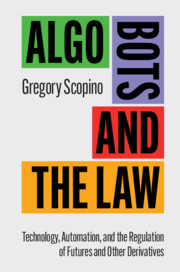Book contents
- Reviews
- Algo Bots and the Law
- Algo Bots and the Law
- Copyright page
- Contents
- Preface
- Introduction
- 1 Key Concepts: Algorithms, Artificial Intelligence, and More
- 2 Economic Definitions of Common Derivatives
- 3 Legal and Regulatory Definitions of Derivatives and Other Financial Instruments
- 4 FinTech: From Science Fiction to Non-Fiction
- 5 The Regulatory Framework for the US Derivatives Markets
- 6 Gateways to the Futures Markets – FCMs
- 7 Collective Investment Vehicles and Investment Advisors
- 8 Salespeople, Supervisors, Owners, and Enumerated Others
- 9 Trading Floor Denizens
- 10 Regulating Digital Intermediaries
- 11 States of Mind: From Zero to Specific Intent
- 12 Market Manipulation: Then and Now
- 13 Fraud Is Many Things (for Humans and Robots)
- 14 Disruptive Trading Practices
- 15 Spoofing: Market Disruption Made Easy by Technology
- 16 Adequately Supervising the Overseers of Algo Bots
- 17 Flash Events
- 18 Algo Bots All over the World
- 19 Conclusion
- Index
5 - The Regulatory Framework for the US Derivatives Markets
Published online by Cambridge University Press: 02 October 2020
- Reviews
- Algo Bots and the Law
- Algo Bots and the Law
- Copyright page
- Contents
- Preface
- Introduction
- 1 Key Concepts: Algorithms, Artificial Intelligence, and More
- 2 Economic Definitions of Common Derivatives
- 3 Legal and Regulatory Definitions of Derivatives and Other Financial Instruments
- 4 FinTech: From Science Fiction to Non-Fiction
- 5 The Regulatory Framework for the US Derivatives Markets
- 6 Gateways to the Futures Markets – FCMs
- 7 Collective Investment Vehicles and Investment Advisors
- 8 Salespeople, Supervisors, Owners, and Enumerated Others
- 9 Trading Floor Denizens
- 10 Regulating Digital Intermediaries
- 11 States of Mind: From Zero to Specific Intent
- 12 Market Manipulation: Then and Now
- 13 Fraud Is Many Things (for Humans and Robots)
- 14 Disruptive Trading Practices
- 15 Spoofing: Market Disruption Made Easy by Technology
- 16 Adequately Supervising the Overseers of Algo Bots
- 17 Flash Events
- 18 Algo Bots All over the World
- 19 Conclusion
- Index
Summary
The federal regulation of futures markets dates back to the Grain Futures Act of 1922, and thus is older than the US government’s securities laws. In the beginning, the primary emphasis of the regulatory regime was to push all futures trading on exchanges that were licensed by the government, with the belief that the exchanges would police trading on their markets for manipulation of the prices of commodities and related misconduct. With time, the government took a more active role in regulating the markets, but the system’s overall emphasis on self-regulation – by exchanges and, starting in the 1980s, also by the NFA – remains to this day. While the primary purpose of federal regulation of futures and derivatives has been the elimination (or, more accurately, the attempted elimination) of market manipulation and disruptive trading practices, other important purposes of the CEA include reducing systemic risk and preventing fraud.
- Type
- Chapter
- Information
- Algo Bots and the LawTechnology, Automation, and the Regulation of Futures and Other Derivatives, pp. 199 - 213Publisher: Cambridge University PressPrint publication year: 2020

